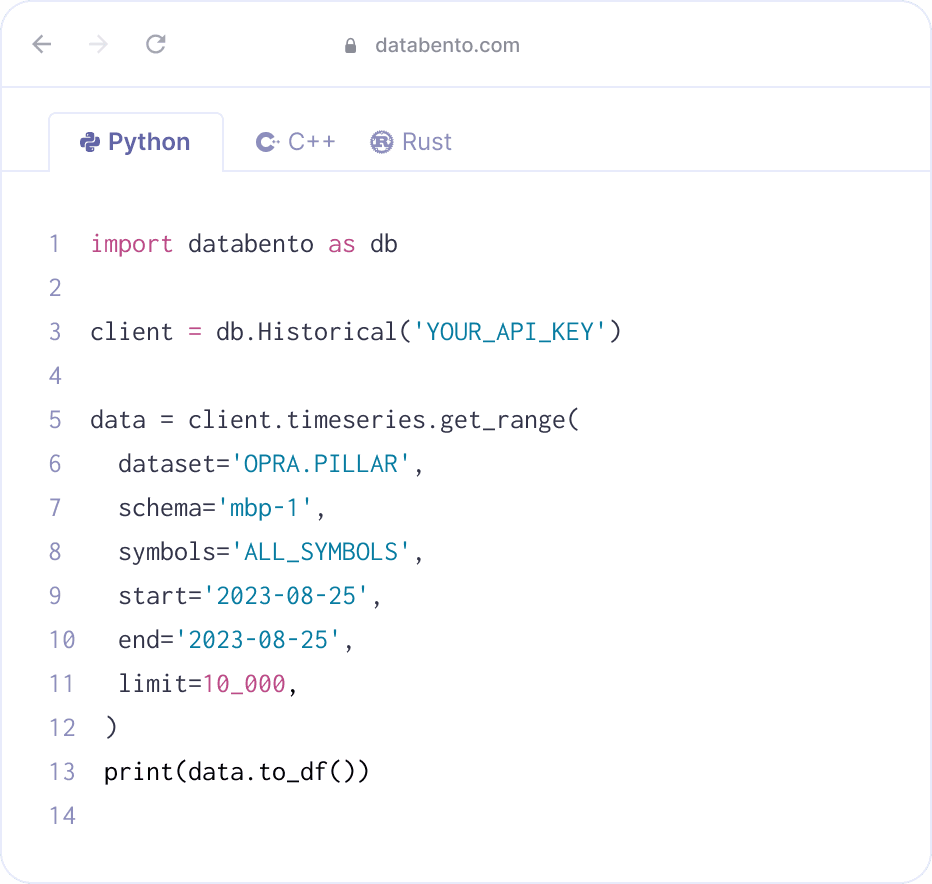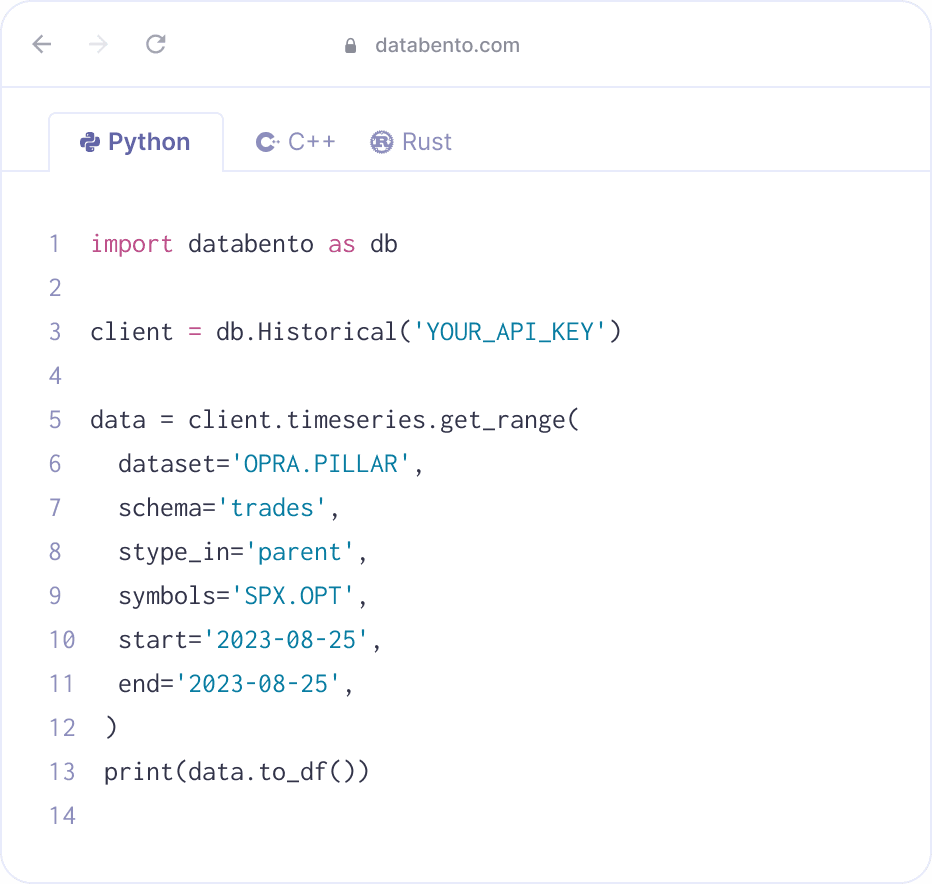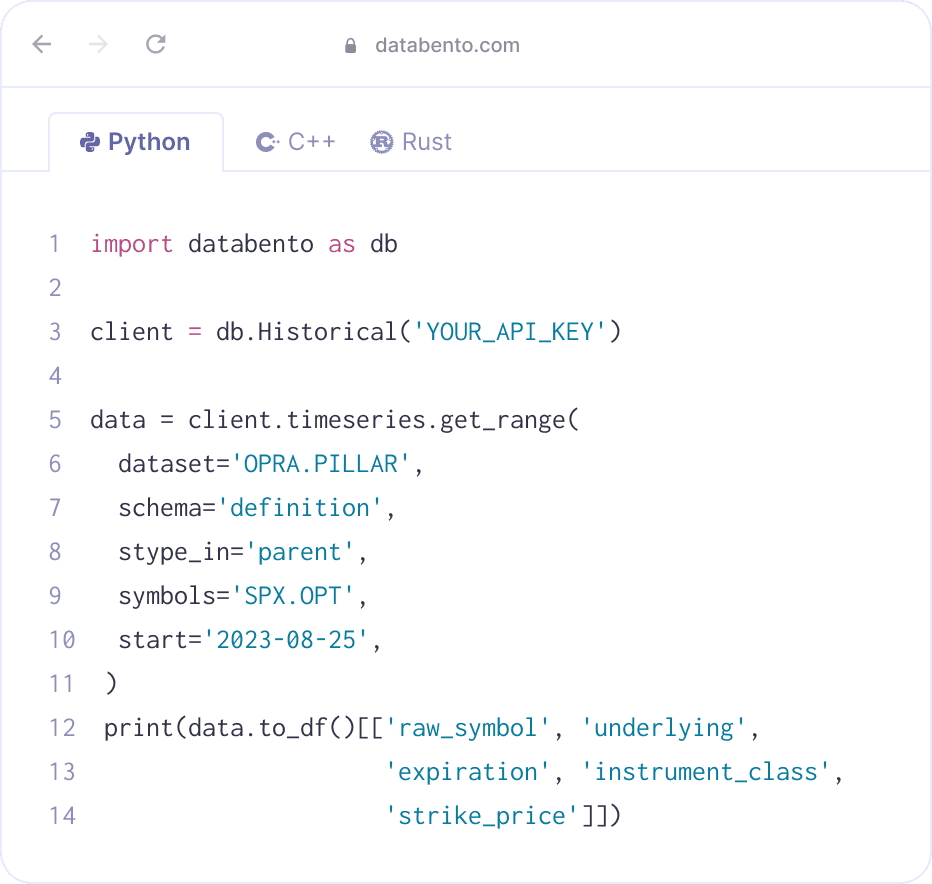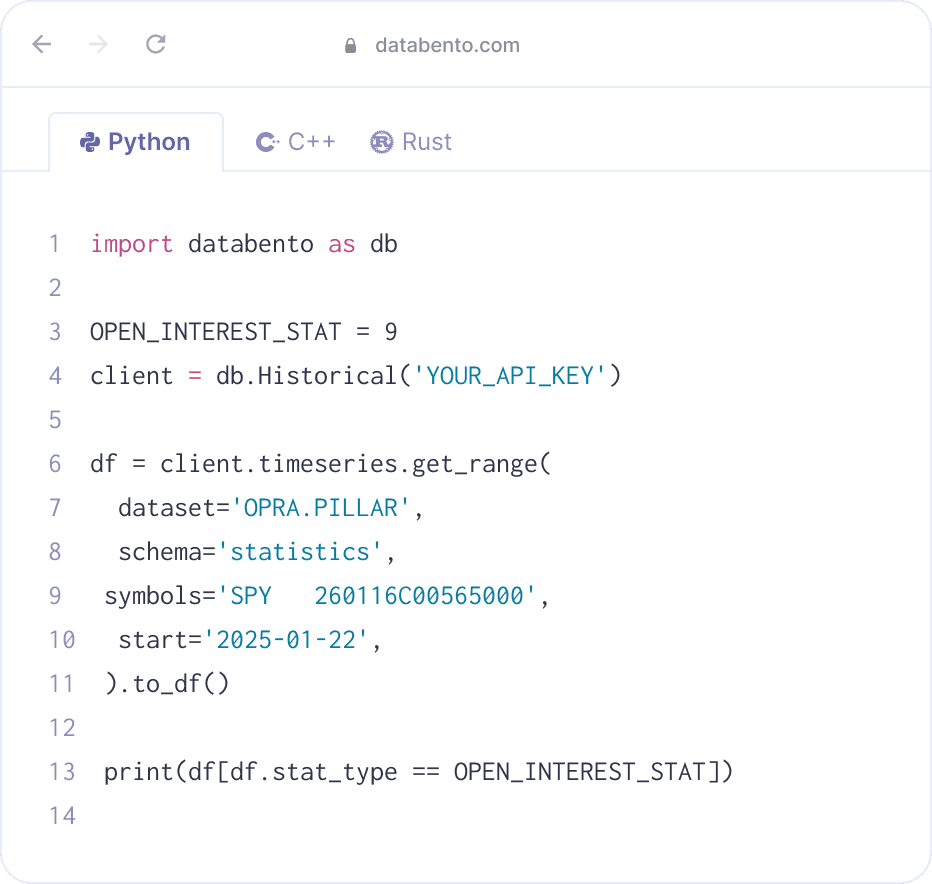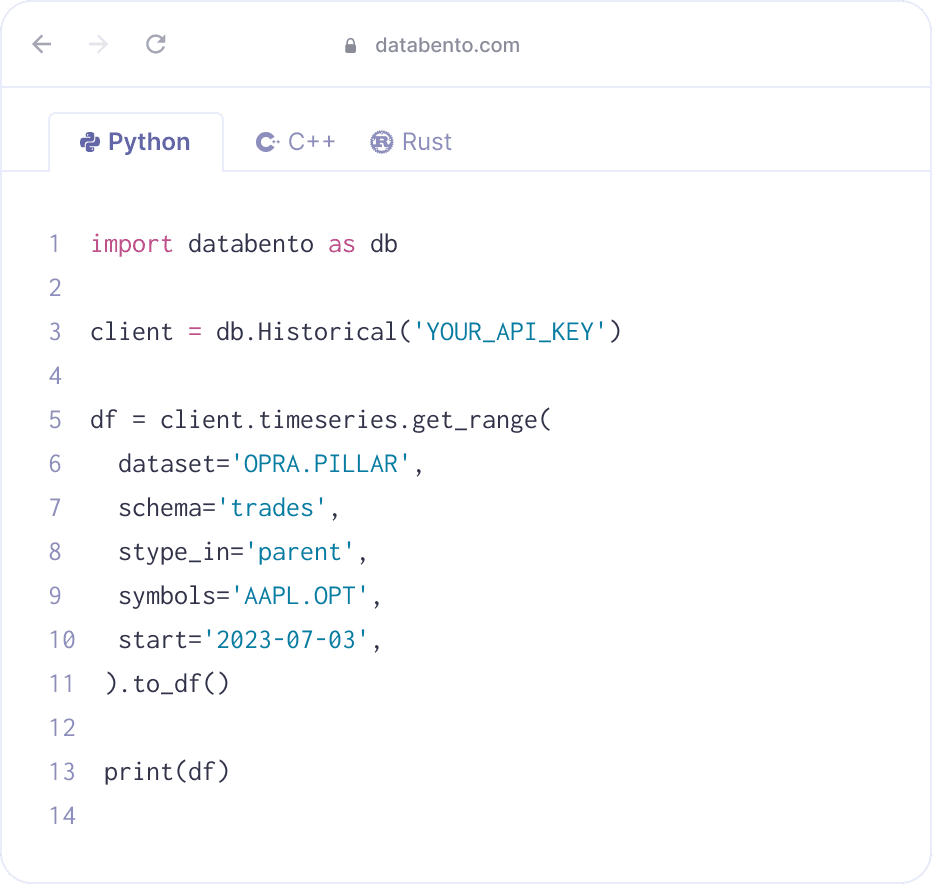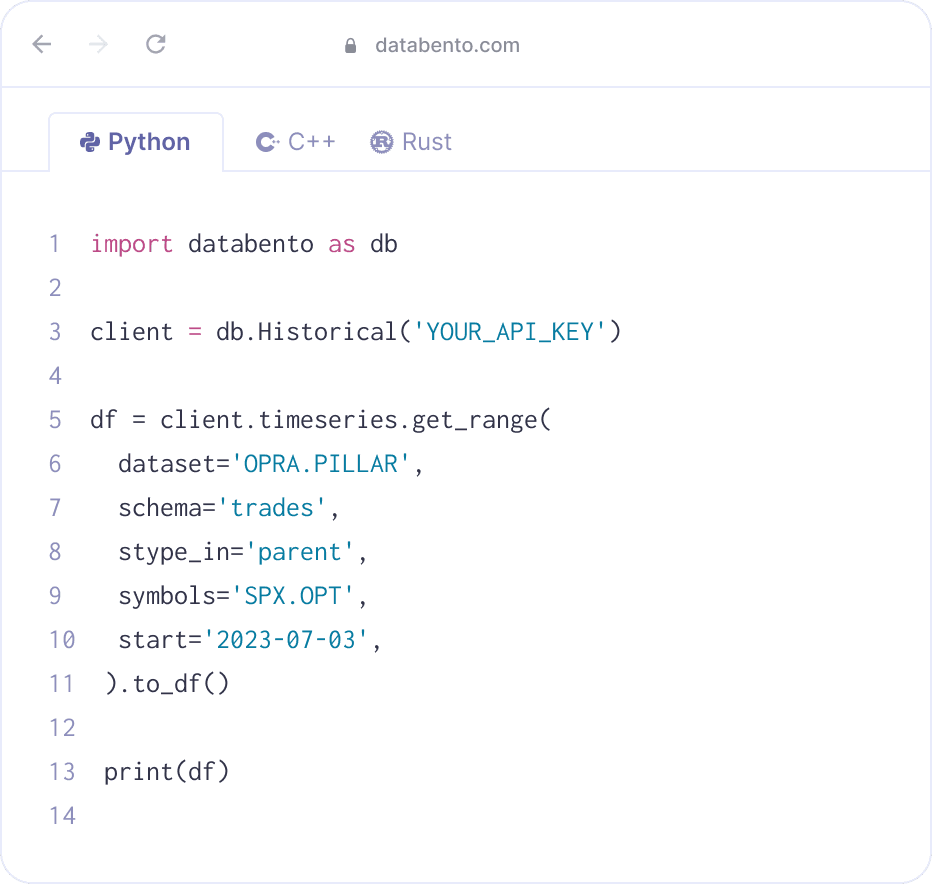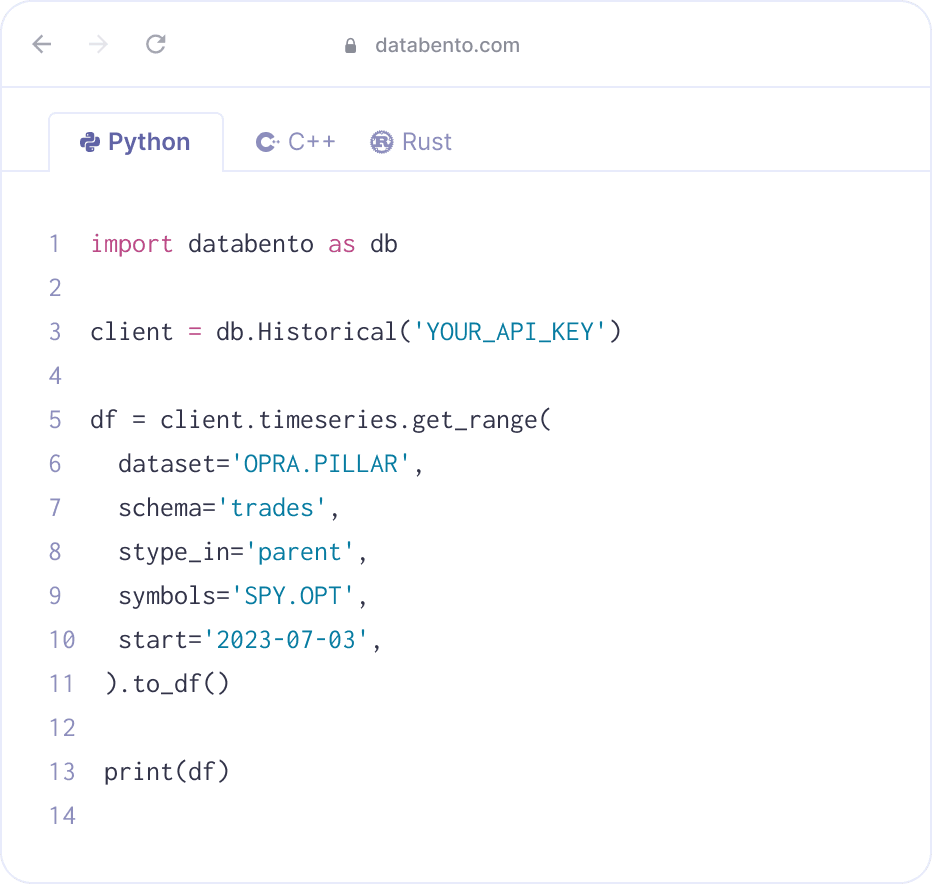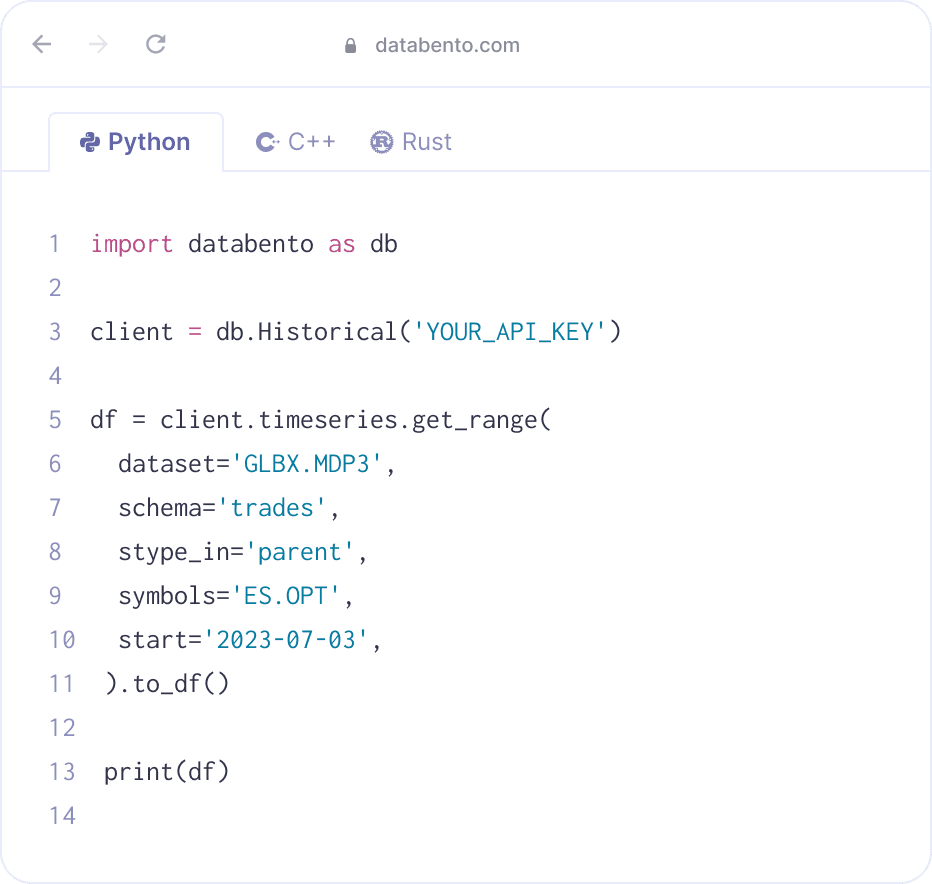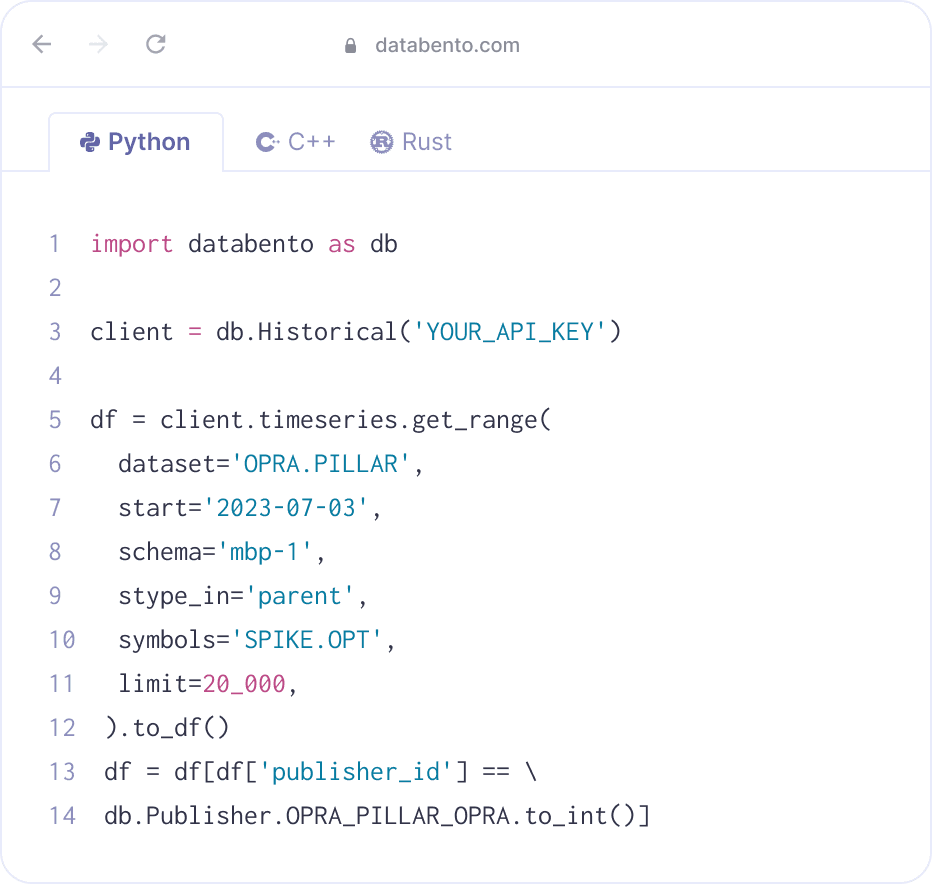Options data
Get real-time and historical options data.
It only takes 3 minutes with our APIs.
60+ trading venues
Easy access through a single API and official client libraries (Python, C++, Rust).
Over 3 million symbols
Includes 1.4+ million US equity options contracts and 600k+ options on futures.
19 PB of coverage
Tick data, full order book, market depth, NBBO, OHLCV, reference data, and more.
Flexible pricing
Only pay for what you use, or get unlimited access with a subscription plan.
Direct from source
Sourced from direct exchange feeds at our Equinix NY4 and Aurora I colos.
Self-service onboarding
Skip the sales call. Access your first dataset in as little as 3 minutes.
List of supported venues
Databento is a licensed distributor and direct provider of market data for 60+ trading venues. See all supported venues ->
OPRA
Equity options
Consolidated last sale, exchange BBO and national BBO across all US equity options exchanges.
Since 2013
1,600,000+ symbols
Historical
Live
CME Globex MDP 3.0
Futures · Options on futures
All futures and options on CME, CBOT, NYMEX, and COMEX. Includes full book, stats, reference data, and more.
Since 2010
650,000+ symbols
Historical
Live
EEX
Futures · Options on futures
Most liquid power market in Europe and a major exchange for natural gas and emissions derivatives.
Since 2018
50,000+ symbols
Historical
Live
Eurex
Futures · Options on futures
Europe's largest derivatives exchange. Covers equity index and fixed income products, as well as single stock options.
Since 2025
600,000+ symbols
Historical
Live
ICE Europe Commodities
Futures · Options on futures
Covers over 50% of global crude and refined oil futures trading. From ICE's iMpact feed.
Since 2018
115,000+ symbols
Historical
Live
ICE Europe Financials
Futures · Options on futures
Covers European equity and interest rate derivatives. From ICE's iMpact data feed.
Since 2018
349,000+ symbols
Historical
Live
ICE Endex
Futures · Options on futures
Leading European energy exchange for gas, power, and emissions. From ICE's iMpact data feed.
Since 2018
115,000+ symbols
Historical
Live
ICE Futures US
Futures · Options on futures
Major softs, metals, MSCI indices, and the US Dollar Index. From ICE's iMpact data feed.
Since 2018
419,000+ symbols
Historical
Live
Equity options
-
BOX Options
-
MIAX Emerald
-
Nasdaq ISE
-
Cboe BZX Options
-
MIAX Options
-
Nasdaq MRX
-
Cboe C2 Options
-
MIAX Pearl
-
Nasdaq Options
-
Cboe EDGX Options
-
MIAX Sapphire
-
Nasdaq PHLX
-
Cboe Options
-
Nasdaq BX Options
-
NYSE American Options
-
MEMX Options
-
Nasdaq GEMX
-
NYSE Arca Options
Options on futures
-
CME
-
ICE Europe Commodities
-
CBOT
-
ICE Europe Financials
-
NYMEX
-
ICE Canada
-
COMEX
-
ICE Abu Dhabi
-
ICE Endex
-
EEX
-
ICE Futures US
-
Eurex
Modern options data APIs built for top financial institutions
Databento works with any language through our APIs. We also provide client libraries for Python, Rust, and C++.
API
Build your first application in 4 lines of code
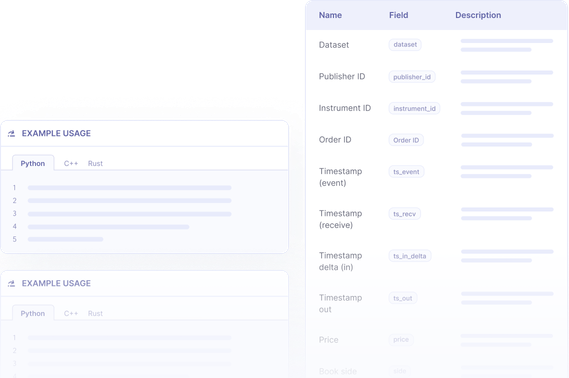
Examples
Simple workflows for options trading
Nanosecond timestamps
The only normalized market data solution to provide up to four timestamps for every event, with sub-microsecond accuracy across venues.
Multiple venues in one
Identify the trading venue behind each quote and get the consolidated NBBO.
Smart symbology
Easy ways to fetch options chains and handle multiple expirations and rollovers.
Customize your data
Select symbols, format, encoding, and delivery. Get any range by the nanosecond.
Read our API reference and user guides
Documentation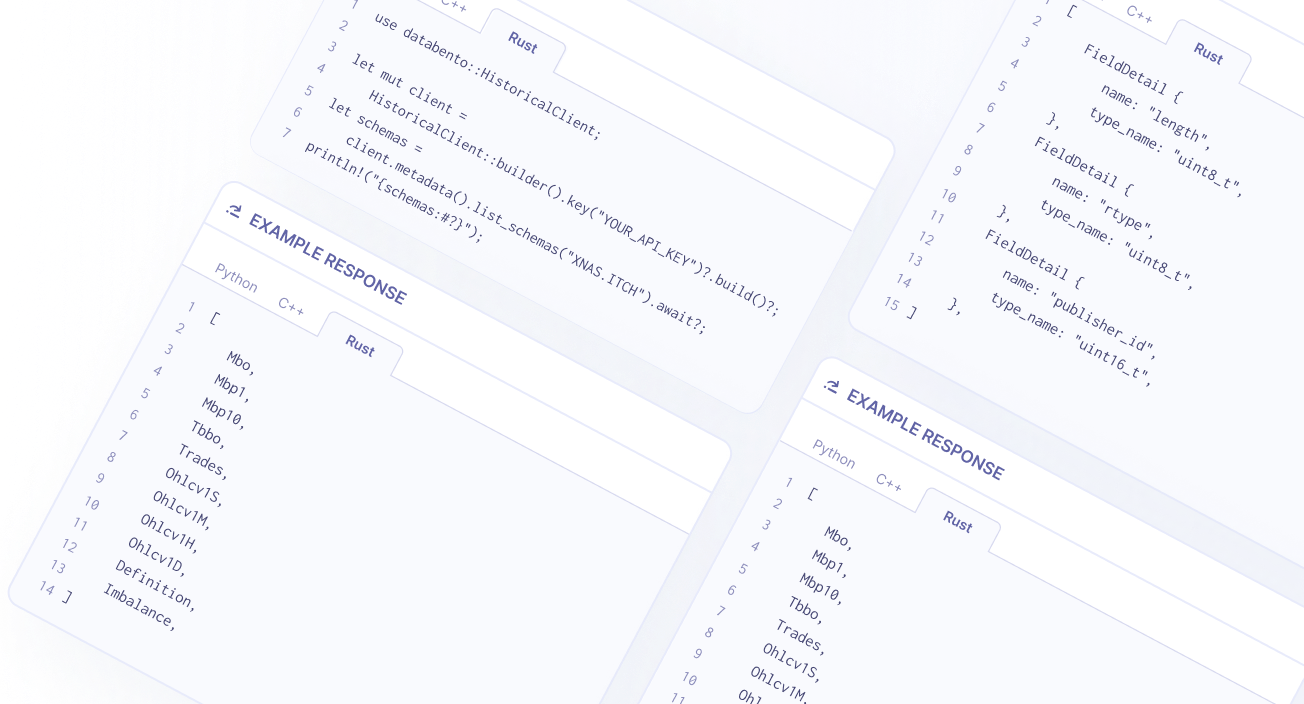
Schemas
Our datasets support multiple formats, including order book, tick data, bar aggregates, and more. View all supported schemas ->
-
mbo
Market by order
Market by order, full order book, L3.
-
mbp-10
Market by price
Market by price, market depth, L2.
-
mbp-1
Market by price
Top of book, trades and quotes, L1.
-
tbbo
Top of book
Top of book, sampled in trade space.
-
trades
Trades
Tick-by-tick trades, last sale.
-
ohlcv-t
Market bars per second
Aggregates per second, minute, hour, or day.
-
definition
Definitions
Point-in-time instrument definitions.
-
imbalance
Imbalance
Auction imbalance, order imbalance.
-
statistics
Statistics
Intraday and end-of-day trading statistics, static data.
Fields
Examples of frequently used data fields. Each schema is represented as a collection of fields. View all supported fields by schema ->
-
publisher_id
Publisher ID
The publisher ID assigned by Databento, which denotes the dataset and venue.
-
instrument_id
Instrument ID
The numeric instrument ID.
-
order_id
Order ID
The order ID assigned at the venue.
-
ts_event
Timestamp (event)
The matching-engine-received timestamp expressed as the number of nanoseconds since the UNIX epoch.
-
ts_recv
Timestamp (receive)
The capture-server-received timestamp expressed as the number of nanoseconds since the UNIX epoch.
-
ts_in_delta
Timestamp (sending)
The matching-engine-sending timestamp expressed as the number of nanoseconds before
ts_recv. -
price
Price
The order price where every 1 unit corresponds to 1e-9, i.e. 1/1,000,000,000 or 0.000000001.
-
action
Action
The event action. Can be Add, Cancel, Modify, cleaR book, Trade, or Fill.
-
size
Size
The order quantity.
-
flags
Flags
A combination of packet end with matching engine status.
-
expiration
Expiration
The last eligible trade time expressed as a number of nanoseconds since the UNIX epoch.
-
strike_price
Strike price
The exercise price if the instrument is an option. Converted to units of 1e-9, i.e. 1/1,000,000,000 or 0.000000001.
API methods
Examples of popular API methods. Our APIs are organized into four categories: metadata, timeseries, symbology, and batch download. View all supported API methods ->
-
timeseries
Get range
Stream time series data using our Historical API.
-
batch
Submit job
Submit a batch job to extract historical data files in bulk.
-
batch
Download
Download a completed batch job.
-
symbology
Resolve
Resolve a list of symbols into their exchange specific identifier.
-
metadata
List publishers
List all our dataset publishers.
-
metadata
List datasets
List all our available dataset names.
-
metadata
Get cost
Get the cost in US dollars for a historical streaming or batch download request.
-
metadata
Get dataset range
Get the available date range for a dataset.
-
metadata
List schemas
List all available market data schemas for a dataset.
Sampling frequencies
All datasets provide full flexibility and the ability to customize sampling resolution.
-
Every book update
Every order execution, add, cancel, replace, book snapshot, and more. By the nanosecond.
-
Tick-by-tick
Every trade and quote. By the nanosecond.
-
1 second
Subsampled BBO, last sale, and OHLCV aggregates by the second.
-
1 minute
Subsampled BBO, last sale, and OHLCV aggregates by the minute.
-
Hourly
OHLCV aggregates by the hour.
-
Daily
Daily market statistics, indicative opening and closing prices, OHLCV aggregates, and more.
What our users are saying

Michael Tung, Investments Lead
Rick Zhan, VP Quant Research
Paul Aston, Founder

Brett Harrison, Founder

Nikita Ostroverkhov, Algo Trading
V. Chen, Equity Research Associate

Chris Pento, Co-founder and CEO
Matt Papakipos
C. Garcia, Senior Quant Researcher
Underlying prices and reference data for options
Corporate actions
Upcoming and historical dividends, splits, and adjustment factors since 2018.
Learn more ->Databento US Equities
Stock and ETF data from 15 US equities exchanges and 30 ATSs. Up to L3 granularity since 2018.
Learn more ->Security master
External symbology mappings since 2005. Includes CUSIP, Bloomberg FIGI, ISIN, CFI, FISN, and CIK.
Learn more ->Frequently asked questions
What types of options contracts do you cover?
We cover all US equity options and options on futures. This includes index options, ETF options, single name stock options, and exchange-traded multi-legged options (combinations) like butterfly spreads, straddles, condors, bundles, strips, etc.
Since we source our data from the full direct feeds, we cover every instrument on each exchange and trading venue—every strike and expiration.
Across US equity options (OPRA), CME, and ICE, we currently cover almost 2 million options tickers that are actively listed on any given day.
Do you cover index options?
Yes. For US equity options, we cover index options (e.g., SPX, VIX), ETF options (e.g., SPY, QQQ), and single name stock options (e.g., AAPL, TSLA, NVDA).
Do you cover options on futures?
Yes, we currently cover options on futures on CME and ICE, two of the largest futures exchanges in the world. This includes all exchange-traded multi-legged options, i.e., combinations and spreads.
Does your options API support fetching multiple option chains, strikes, or expirations at the same time?
Yes, you can use parent symbology to fetch all strikes and expirations for a root symbol. Likewise, you can specify multiple parent symbols in a single API request.
Does Databento publish pre-calculated implied volatility and greeks?
We don't currently provide pre-calculated implied volatility (IV) or greeks.
You can IV calculate and greeks from our options prices with an options pricing model. An example of calculating IV of index futures with the Black-76 model is shown in our documentation.
Our API design prioritizes transparency by avoiding vendor-calculated or derived data, such as IV and greeks, which are highly sensitive to the choice of model parameters and inputs. Instead, we usually prefer to provide tutorials and code samples so that you can do this on your end.
Do you provide reference data like expiration dates and open interest?
Yes, these are available on our instrument definitions and statistics schemas, respectively.
What is OPRA?
The Options Price Reporting Authority (OPRA) consolidates and disseminates last sale, NBBO, local exchange quotes, and other regulatory market data across all US equity options exchanges. This is the primary source of US equity options data for most firms and vendors.
The OPRA feed covers all index options, ETF options, and single name stock options on US equity options exchanges.
To find out more, see our microstructure guide.
What symbology system do you use for individual tickers?
Our raw symbols for equity options are based on OCC symbology, also known as Options Symbology Initiative (OSI) symbology. The OPRA dataset specification provides an overview of this symbology format.
Do you provide proprietary feeds from individual equity options exchanges like Cboe Depth of Book (PITCH)?
It's less typical for vendors and trading participants to employ US options data sourced from proprietary feeds due to its large size. While we currently provide US stock and ETF data from proprietary direct feeds, we currently don't provide this for equity options.
If you're interested in US equity options data from proprietary feeds, you can create a ticket on our public roadmap.
How fast is your real-time options data? Can it keep up with the full OPRA feed during market open and close?
You can see it in action for yourself on our live latency dashboard, which shows latency percentiles at specific times of the day.
